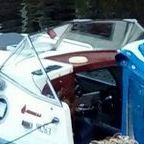-
Posts
61 -
Joined
-
Last visited
Profile Information
-
Gender
Male
-
Location
Bury St Edmunds
Recent Profile Visitors
1,654 profile views
towpathrider's Achievements
Engager (3/12)
0
Reputation
-

Connecting two skin tanks
towpathrider replied to towpathrider's topic in Boat Building & Maintenance
Thanks, just checking what you mean by fully vented? Do you mean in order to bleed them when re-filling? (both tanks have bleed points) otherwise, the coolant is vented at the engines' header tanks. -
I currently have two skin tanks, one connected to a beta 38, which provides propulsion and the other connected to a beta 35, which runs a genset. The engines are never used simultaneously. The beta 38 skin tank is undersized, and while this hasn't been an issue yet on canals I'd like to connect the two tanks to allow for more cooling capacity if on rivers/tidal. Would a simple connecting hose/pipe between the two tanks be sufficient enough to allow coolant to flow between the tanks, if it is of sufficient bore i.e. 28mm?
-

Another back boiler post
towpathrider replied to towpathrider's topic in Boat Building & Maintenance
What do you think of the third diagram? I don't understand how hot water circulates into a rad, if the hot connections go down into the rad. But this how hot water feed is connected in smileypete's design, with the rads in between the pipes. I should also mention that my diagram is inaccurate in that the hot feeds for the rads will not rise and then go down, but instead rise steadily to the rad inlet. This way hopefully each rad should thermosyphon, as in the solar diagram above? -

Another back boiler post
towpathrider replied to towpathrider's topic in Boat Building & Maintenance
Yes, but you can have convection without thermosyphoning right? -

Another back boiler post
towpathrider replied to towpathrider's topic in Boat Building & Maintenance
I think that the way this would work wold be through convection, rather than thermosyphoning, and I'm led to beleive thermosyphoning is more efficient, as the water is effectively pumping itself around the system. -

Another back boiler post
towpathrider replied to towpathrider's topic in Boat Building & Maintenance
Am I right In thinking Rad 2 won't work because the cold outlet has to rise in order to get to the return pipe? Would the siphoning effect work if the cold outlet is above the level of the cold inlet on the back boiler? Lastly, would it be weird to mount a radiator like rad 1, though in the bedroom it would be on the wall. Would the heat distribute throughout the room much less efficiently than one mounted further down? LIke this: -

Another back boiler post
towpathrider replied to towpathrider's topic in Boat Building & Maintenance
Thanks for the diagrams, I had seen them, but my problem as I mentioned is I can't put the rads between the main pipes, they're currently only about 20cm apart, and pass through numerous bulkheads. So I'm trying to plan a system where the rads either go below, or above the pipes. In all cases, the top of the rad will be above the hot (top) back boiler outlet. Here's a re-drawn diagram. -
I have read the other back boiler posts, but I know most systems have their individual quirks, so wanted to post ours and get some feedback. Our system so far just has the 28mm loop with a substandard header tank arrangement, so I'm looking to upgrade with a couple of rads. Spcifically there are a couple of things I wanted to check: 1. Do I need two pipes going to the header tank? If so, why? (header tank will be vented, and unpressurised) 2. I will have to place rads either above of below pipework, (can't really put them over the top?) will the rad below in the bedroom work?
-
Thanks for the replies, I've actually found some multi stranded cable that is reasonably priced, so will probably go with that, had I gone with the earth wire then I would mark it using electrical tape at regular intervals so that it was clear which was positive and negative. I also plan to have a wiring diagram clearly placed in the engine room for my own, and any future owners use. The choice of 16mm wire was purely down to voltage drop, this circuit will ONLY be for sockets and a few devices, (fridge, lights pumps are wired on separate circuits) but as I mentioned I have a powerful laptop that I would like to be able to use occasionally, (yes I know!) and If it was used at the far end, (most likely, as this is the seating area) then a 10 amp draw at 12v over 15m would mean a voltage drop of nearly 5% - to about 11.9V, and that's if nothing else is attached to the circuit. It might seem stupid to size the circuit according to one device that won't be used all the time, but since it's only something I am going to do once I'd like to have that option. I don't expect to draw 30a from the whole circuit at any one time, so will fuse it at 30a on the 12v distribution fuseboard, and yes, I will fuse each additional spur as well. As I will be using 6mm2 and 4mm2 for spurs their current carrying capacity will not be exceeded without blowing either the main 30a fuse or the spur fuse. I beleive the maximum rated ATO fuse is 40a, so if someone did replace, that's the maximum. as to the connections, I have found these open copper crimps http://www.amazon.co.uk/10Pcs-Open-Copper-Terminals-Wire/dp/B00R1IYCNK/ref=sr_1_2?ie=UTF8&qid=1460738116&sr=8-2&keywords=open+copper+crimp+10 - which could be crimped to a stripped but unbroken wire, I then plan to use to heatshrink tape and/or self amalgamating rubber for insulation. If properly sized to the cable and well crimped, I would have thought this should made a good mechanical and electrical connection?
-
Ok thanks for all the advice, I will try and source some stranded wire. It still seems theres no easy or straightforward way to wire multiple connections to the 16mm though.
-
By terminal blocks do you mean chocolate block connectors? When getting the boat a couple of years ago the surveyor seemed particularly anti those, and I dont think they provide an ideal mechanical or electrical connection. Plus not sure I could get large enough ones for 16mm. I'd also like to avoid cutting the 16mm where possible. At the risk of sounding facetious Should I be worried about vibration with copper gas piping, or indeed in my alternator? Hopefully I can find multi strand at a good price, though (call me stubborn) I would be very surprised if the cable broke within the lifetime of the boat. Has anyone experienced this happening with heavy gauge cable, which has been frequently secured (say every 10cm or so) throughout its length? As I mentioned earlier, my boat was wired fairly extensively with solid strand wire, some of it poorly secured. None of it had broken, or even appeared brittle. Some of the multi strand wire had, however turned black inside the insulation and become very brittle - almost dusty. Presumably due to moisture/oxygen getting under the insulation, which is what the better marine tinned cable should avoid.
-
Ok, thanks. I checked and the wire is 7 strand, BS EN 50525-2-31 which I believe replaces BS6004.
-
Hmm. . . I think there are a lot of people on here who like to throw regulations at a problem (often without referencing them) perhaps to prove they know better etc. . . First of all, the cable type is a recommendation. There was a lot of solid strand cable in the boat already, and it got through a BSS, no problem. Does that mean the BSS inspector/surveyor is a "rank amateur" ? Maybe we coukd have a constructive conversation about why the recommendation is in place? From what I have read, and please correct me, the problem with solid strand wire is mainly due to stress fracturing, and I certainly would not use solid strand 1.5mm twin mains wire for 230v, due to this, even though plenty was fitted in my boat when it passed BSS, and i have subsequently replaced it. I cant imagine 16mm fracturing under stress though. But are there any other reasons is this recommendation is in place? http://www.clevelandcable.com/products/658tq-marine-cable-offshore-cable-bs6883-ukooa-6mm300mm-p/ How many of you can honestly say your 30 year old boats are fully wired with bs6883 cable? I'm not trying to say that just because other people flout regulations means that its ok, but lets have a constructive argument about why its a recommendation. If people know why they shouldn't break rules, then they will more likely follow them. As to the connection methods, whats so dodgy about them? I will be running several sockets, and a couple of 12v applicances directly from this 16mm2 circuit, each socket is fused, and each appliance will be fused as well. I plan to use 6mm or 4mm cable for the spurs. Max current draw from any one socket will be 10a (occasional use of powerful laptop) The appliances will be a small tv/monitor, 12v stereo, and maybe a couple of 5v usb devices via a buck converter. I'm not set on doing it "my way", otherwise I wouldn't have bothered with the post, If you were to wire 16mm2 12v to "best practice" standards how would you do it?
-
Can anybody point me towards the documentation? Is this a recommendation or a requirement for BSS "marine" gets a lot more extreme than interior under gunwhale wiring on inland waterways. The cable won't be going inside the engine room, 12v distribution is on engine room bulkhead in rear cabin. Yes this is a rewire, its not a new boat.
-
I think it has 6 strands, will have to check. But it would be hard to cut through one with a stanley knife. I know i could probably have gotten away with using smaller cable, but using this method I would still have the same problem, unless the cable was small enough to solder, and in my experience getting larger cables hot enough to flow solder is impractical and melts insulation. Maybe im just doing it wrong. . .





